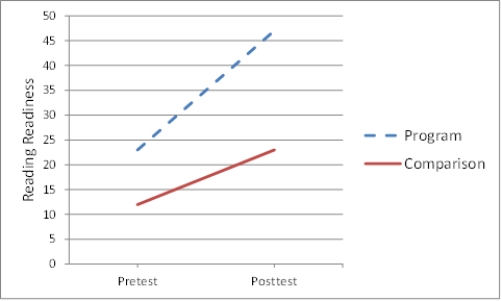Narrative 10-1 -Daycare Center - Part I
Ken studies literacy and is particularly concerned about children who lag in reading readiness.He has developed a reading readiness program that can easily be implemented by day care providers in group settings,and has selected two day cares in demographically similar neighborhoods.He starts by giving a reading readiness to all of the three- and four-year-olds in both day care centers.
Figure TB 10-11

-Ken decides to implement his intervention at one daycare but not the other,and after the intervention is complete,he administers the reading readiness test again to both groups of children.His results are shown in the accompanying figure.When Ken talks to reading specialists,he learns that children often progress slowly at first,but when their readiness skills reach a certain point,they seem to take off.Thus children who started at a higher level,like those in his intervention group,may improve faster than children who start off at a lower level,like his comparison group.Given this,it is possible that Ken's results reflect not his intervention,but rather,____ effects.
A) selection-maturation
B) selection-mortality
C) selection-regression
D) selection-diffusion
Correct Answer:
Verified
Q29: Figure TB 10-3
Q29: Figure TB 10-3
Q33: It is possible to mitigate the non-equivalency
Q35: Figure TB 10-2
Unlock this Answer For Free Now!
View this answer and more for free by performing one of the following actions

Scan the QR code to install the App and get 2 free unlocks

Unlock quizzes for free by uploading documents